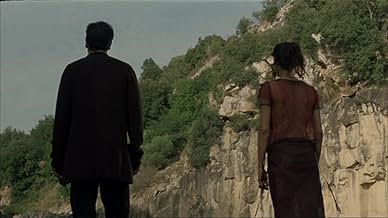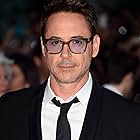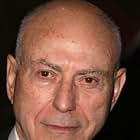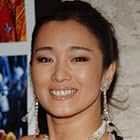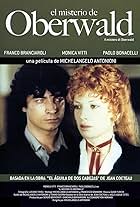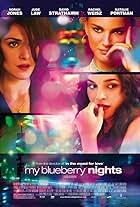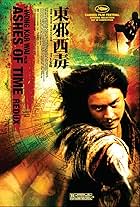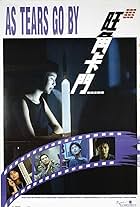IMDb RATING
5.9/10
7.4K
YOUR RATING
Three short films, one each from Directors Michelangelo Antonioni, Steven Soderbergh, and Wong Kar Wai, address the themes of love and sex.Three short films, one each from Directors Michelangelo Antonioni, Steven Soderbergh, and Wong Kar Wai, address the themes of love and sex.Three short films, one each from Directors Michelangelo Antonioni, Steven Soderbergh, and Wong Kar Wai, address the themes of love and sex.
- Awards
- 1 win & 1 nomination
Feng Tien
- Master Jin (segment "The Hand")
- (as Tin Fung)
Chun-Luk Chan
- Hua's Servant - Ying (segment "The Hand")
- (as Auntie Luk)
Jianjun Zhou
- Hua's Lover - Zhao (segment "The Hand")
- (as Zhou Jianjun)
Wing Tong Sheung
- Tailor (segment "The Hand")
- (as Sheung Wing Tong)
Kim Tak Wong
- Tailor (segment "The Hand")
- (as Wong Kim Tak)
Siu Man Ting
- Tailor (segment "The Hand")
- (as Ting Siu Man)
Lai Fu Yim
- Tailor (segment "The Hand")
- (as Yim Lai Fu)
Cheng You Shin
- Tailor (segment "The Hand")
- (as Shih Cheng You)
Wing-Kong Siu
- Tailor (segment "The Hand")
- (as Siu Wing Kong)
Kar Fai Lee
- Tailor (segment "The Hand")
- (as Lee Kar Fai)
Chi Keong Un
- Hotel Concierge (segment "The Hand")
- (as Un Chi Keong)
Storyline
Did you know
- TriviaMichelangelo Antonioni's segment was filmed in English. It was later dubbed into Italian after hostile critical reactions at initial test screenings.
- Alternate versionsThere is an extended version of Wong's 48' segment "The Hand" that runs at 56' released as a standalone short The Hand (2004).
- ConnectionsEdited into The Hand (2004)
Featured review
What a treat! A film school in 104 minutes!
Forget what the detractors say about this. Most seem to think that none of it is erotic enough and few "like" the Soderbergh and Antonioni projects.
But you, dear viewer, you will know this as three explorations into how the eye creates the seductive impulse. And we have three masters, though I wish we also had Greenaway and Medem involved.
I assume that these three did not collaborate in any way. I also assume that the sponsors did not specify that the projects be erotic, rather that they explore what it means to be erotically engaged.
The first we see is by Kar-Wai Wong. His object of desire is Gong Li, who at 40 is still beautiful. She plays a prostitute who conspires to replace her old dressmaker with a young man. (The subtitles call him a tailor, to emphasize the tale that he spins.)
She engages his desire-driven imagination, which binds him to her and brings out his very best in terms of the dresses he creates. She weaves him and through the clothes, he weaves her. Toward the end, the image is polished with her ill and out of favor, and he still as obsessed and caressing a dress he made, moving his entranced hand inside it. It is his hand the title denotes.
At the very end, he tells a tale to his boss of his woman as back in the money, now fully his creation.
The second entry is amazing. Soderbergh is often capable of creating plots with circular reference. And since the very beginning, this notion of one reality creating another has been at his center. But this outdoes even "Full Frontal."
We have three dreams. One is the one we see first, a gauzy look through windows at an amazingly engaging scene: a beautiful redhead bathing and dressing. The dream starts as voyeurism through windows, but as is described later, our voyeur enters the dream as a participant. In the dream, he is on the bed dreaming.
Shift to a psychiatrist's office, where we meet the dreamer, played by Downey, one of our few folded actors. He is a clock designer obsessed with this dream. Over time, he is enticed to lay down and segue from talking about the dream to actually enter the dream. During this time, the psychiatrist begins his own voyeurism out the window.
Most reviewers saw this and thought the comic indifference was the point. Oh my. Their license to view films should be revoked.
As Downey dreams, we enter the third world, the third dream. He pulls a trigger suggested in the earlier segment and wakes into the dream where he is now married to his desire, and he goes to clock-designer work where his assistant is the same guy as the analyst, except he is the one obviously insecure.
All three worlds are set in the 50s. Which is the dream? Which is the source of pulling the desire into reality? Are dreams of desire cinematic or the other way around? Which of the paper airplanes connect?
The third project is widely dismissed as the obsessive sexual impetulance of an old, fading man.
The scene here is simple. A husband and wife have a spat. She is topless at first then puts on a transparent top as they go to a restaurant. There they briefly encounter another inhabitant of the beach resort where this is set. He visits this woman and they seduce each other, apparently a single event.
Later, the husband and wife are reconciled. Both woman happen to be nude on the beach, both seemingly in a sensual plateau. They encounter each other; more precisely the wife encounters the other asleep, casts a shadow on her while she stirs. They stare at each other silently. Neither, incidentally, is particularly attractive.
When the man and his affair begin, he has entered the "other" tower on the beach, after she wonders if he can stand her chaos, absolute chaos. Viewers seem to equate this with his famed trilogy about love from the sixties. Those were dumb films.
How could they forget "Blowup," an essay on how cinematic memory bends or even defines reality. And how he stretched that into wonderful folded space in "Beyond the Clouds."
You have to do some work here. You have to know that this is not about sex, or the erotic figure. Nor even anything at all having to do with examining a relationship. It is all about how perception defines the situation, moved erotically.
Guess no one want to do the work. But if you are interested in film, you'll want to view these three notions of where the eye of love sits. With Wong, it is in the present, Soderbergh in the remembered and Antonioni the expected.
I prefer Wong's world so far as experience. He even takes it as far as not having a script, but making up the movie as he shoots. Love should ideally be erotic, and the invention of that world should be one you coweave with your partner, dressing each other into the miracle.
But these other fellows have hypnotic appeal as well.
Ted's Evaluation -- 2 of 3: Has some interesting elements.
Forget what the detractors say about this. Most seem to think that none of it is erotic enough and few "like" the Soderbergh and Antonioni projects.
But you, dear viewer, you will know this as three explorations into how the eye creates the seductive impulse. And we have three masters, though I wish we also had Greenaway and Medem involved.
I assume that these three did not collaborate in any way. I also assume that the sponsors did not specify that the projects be erotic, rather that they explore what it means to be erotically engaged.
The first we see is by Kar-Wai Wong. His object of desire is Gong Li, who at 40 is still beautiful. She plays a prostitute who conspires to replace her old dressmaker with a young man. (The subtitles call him a tailor, to emphasize the tale that he spins.)
She engages his desire-driven imagination, which binds him to her and brings out his very best in terms of the dresses he creates. She weaves him and through the clothes, he weaves her. Toward the end, the image is polished with her ill and out of favor, and he still as obsessed and caressing a dress he made, moving his entranced hand inside it. It is his hand the title denotes.
At the very end, he tells a tale to his boss of his woman as back in the money, now fully his creation.
The second entry is amazing. Soderbergh is often capable of creating plots with circular reference. And since the very beginning, this notion of one reality creating another has been at his center. But this outdoes even "Full Frontal."
We have three dreams. One is the one we see first, a gauzy look through windows at an amazingly engaging scene: a beautiful redhead bathing and dressing. The dream starts as voyeurism through windows, but as is described later, our voyeur enters the dream as a participant. In the dream, he is on the bed dreaming.
Shift to a psychiatrist's office, where we meet the dreamer, played by Downey, one of our few folded actors. He is a clock designer obsessed with this dream. Over time, he is enticed to lay down and segue from talking about the dream to actually enter the dream. During this time, the psychiatrist begins his own voyeurism out the window.
Most reviewers saw this and thought the comic indifference was the point. Oh my. Their license to view films should be revoked.
As Downey dreams, we enter the third world, the third dream. He pulls a trigger suggested in the earlier segment and wakes into the dream where he is now married to his desire, and he goes to clock-designer work where his assistant is the same guy as the analyst, except he is the one obviously insecure.
All three worlds are set in the 50s. Which is the dream? Which is the source of pulling the desire into reality? Are dreams of desire cinematic or the other way around? Which of the paper airplanes connect?
The third project is widely dismissed as the obsessive sexual impetulance of an old, fading man.
The scene here is simple. A husband and wife have a spat. She is topless at first then puts on a transparent top as they go to a restaurant. There they briefly encounter another inhabitant of the beach resort where this is set. He visits this woman and they seduce each other, apparently a single event.
Later, the husband and wife are reconciled. Both woman happen to be nude on the beach, both seemingly in a sensual plateau. They encounter each other; more precisely the wife encounters the other asleep, casts a shadow on her while she stirs. They stare at each other silently. Neither, incidentally, is particularly attractive.
When the man and his affair begin, he has entered the "other" tower on the beach, after she wonders if he can stand her chaos, absolute chaos. Viewers seem to equate this with his famed trilogy about love from the sixties. Those were dumb films.
How could they forget "Blowup," an essay on how cinematic memory bends or even defines reality. And how he stretched that into wonderful folded space in "Beyond the Clouds."
You have to do some work here. You have to know that this is not about sex, or the erotic figure. Nor even anything at all having to do with examining a relationship. It is all about how perception defines the situation, moved erotically.
Guess no one want to do the work. But if you are interested in film, you'll want to view these three notions of where the eye of love sits. With Wong, it is in the present, Soderbergh in the remembered and Antonioni the expected.
I prefer Wong's world so far as experience. He even takes it as far as not having a script, but making up the movie as he shoots. Love should ideally be erotic, and the invention of that world should be one you coweave with your partner, dressing each other into the miracle.
But these other fellows have hypnotic appeal as well.
Ted's Evaluation -- 2 of 3: Has some interesting elements.
- How long is Eros?Powered by Alexa
Details
- Release date
- Countries of origin
- Official site
- Languages
- Also known as
- Ерос
- Filming locations
- Production companies
- See more company credits at IMDbPro
Box office
- Gross US & Canada
- $188,392
- Opening weekend US & Canada
- $53,666
- Apr 10, 2005
- Gross worldwide
- $1,553,020
- Runtime1 hour 44 minutes
- Color
- Sound mix
- Aspect ratio
- 1.85 : 1
Contribute to this page
Suggest an edit or add missing content






